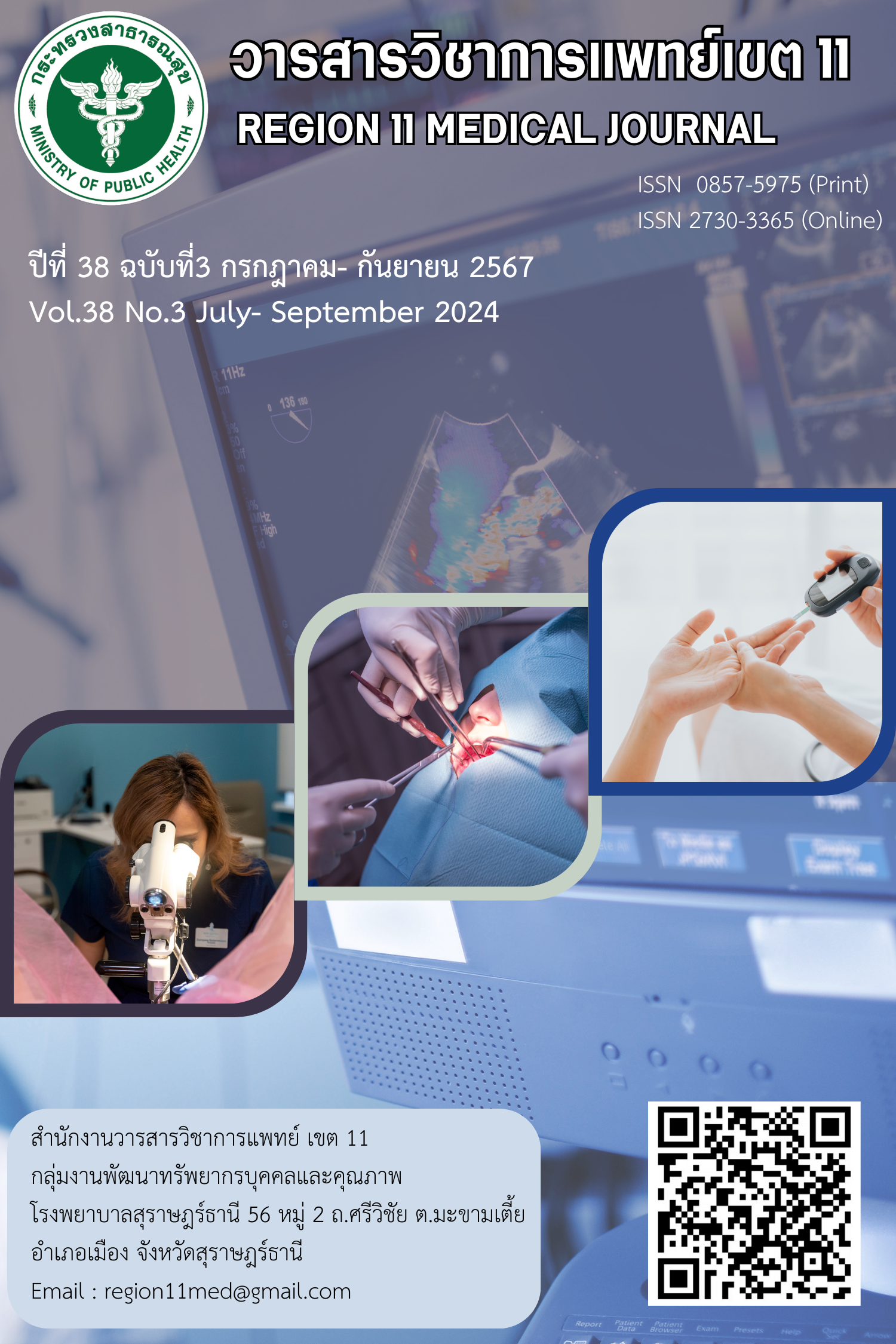The effectiveness of using range order opioid analgesic management approach for the prevention of Opioids-Induced Advancing Sedation (OIAS) in patients after thoracic surgery
Keywords:
Opioids, Range order, Thoracic surgeryAbstract
Background: Managing pain using opioids through a range of prescriptions is flexible. So that nurses can use opioids to control pain in each patient. Therefore, the administration of opioids is inappropriate, including frequency, size, and without consideration of other risk factors in patients that cause opioid overdose and there is no continuous monitoring. This resulted in the incidence of the complications to be Opioids-Induced Advancing Sedation (OIAS)
Objectives: To study the results of using guidelines for administering range order opioids to prevent OIAS in post-thoracic surgery patients.
Method: It is developmental research. This is the phase of testing the effectiveness of the guidelines (Step 8 of the National Health and Medical Research Council's Clinical Guideline Development Conceptual Australia Framework). The sample group is Thoracic surgery patients receiving epidural opioid pain relievers There were 62 people aged 18-60 years, divided into a control group and an experimental group, 31 people each. Data were collected by following up prospectively and comparing the results with traditional care. Data were analyzed using descriptive statistics. and independent statistics.
Results: The mean pain scores between the control group and the experimental group 24 hours after surgery were not significantly different at the .05 level, but after 48 hours and 72 hours of surgery, the mean pain scores between the control group and the experimental group were not significantly different at the .05 level. Statistically significantly different (p < .05). The number of OIAS events decreased from 6 times to 1 time and when comparing the differences. It was found that there was a statistically significant difference (p < .05).
Conclusion: Guidelines for administering opioid pain relievers in phases Helps reduce and prevent the occurrence of OIAS in patients after thoracic surgery.
References
Drew DJ, Gordon DB, Morgan B, Manworren RCB. ‘‘As-Needed’’ range orders for opioid analgesics in the management of pain: A consensus statement of the American Society for pain management nursing and the American Pain Society. Pain Manag Nurs 2018;19(3):207-10. https://doi.org/10.1016/j.pmn.2018.03.003.
สถิติหอผู้ป่วยศัลยกรรมชาย 2 โรงพยาบาลหาดใหญ่. สถิติผู้ป่วยผ่าตัดทรวงอกปี พ.ศ. 2564-2566. สงขลา: โรงพยาบาลหาดใหญ่; 2566.
National Health and Medical Research Council. A guide to the development, implementation and evaluation of clinical practice guidelines. 1998. https://www.nhmrc.gov.au/sites/default/files/images/a-guide-to-the-development-and-evaluation-of-clinical-practice-guidelines.pdf.
ราชวิทยาลัยวิสัญญีแพทย์แห่งประเทศไทยร่วมกับสมาคมการศึกษาเรื่องความปวดแห่งประเทศไทย. แนวทางพัฒนาการระงับปวดเฉียบพลันหลังผ่าตัด. (ฉบับที่ 2). ราชวิทยาลัยวิสัญญีแพทย์แห่งประเทศไทย 2560.
Chou R, Gordon DB, de Leon-Casasola OA, Rosenberg JM, Bickler S, Brennan T, Guidelines on the management of postoperative pain management of postoperative Pain: A clinical practice guideline from the American Pain Society, the American Society of Regional Anesthesia and Pain Medicine, and the American Society of Anesthesiologists’ Committee on Regional Anesthesia, Executive Committee, and Administrative Council. The Journal of Pain 2016;17(2):131-57.
Drew DJ, Gordon DB, Renner L, Morgan B, Swensen H, Manworren R. The use of "as-needed" range orders for opioid analgesics in the management of pain: a consensus statement of the American Society of pain management nurses and the American Pain Society. Pain Manag Nurs 2014;15(2):551-4. DOI: 10.1016/j.pmn.2014.03.001.
Gordon DB, Dahl J, Phillips P, Frandsen J, Cowley C, Foster RL, et al. The use of "as-needed" range orders for opioid analgesics in the management of acute pain: a consensus statement of the American Society for pain management nursing and the American Pain Society. Pain Manag Nurs 2004;5(2):53-8. DOI: 10.1016/j.pmn.2004.04.001.
Gordon DB, Pellino TA, Higgins GA, Pasero C, Murphy-Ende K. Nurses' on appropriate administration of PRN range opioid analgesic orders for acute pain. Pain Manag Nurs 2008;9(3):131-40. doi: 10.1016/j.pmn.2008.03.003.
Jungquist CR, Smith K, Wiltse Nicely KL, Polomano RC. Monitoring hospitalized adult patients for opioid-induced sedation and respiratory depression. AJN 2017;117(3):27-35.
Jungquist CR, Quinlan-Colwell A, Vallerand A, Carlisle HL, Cooney M, Dempsey SJ, et al.
American Society for pain management nursing guidelines on monitoring for opioid-induced advancing sedation and respiratory depression: revisions. Pain Manag Nurs 2020;21(1):7-25. doi: 10.1016/j.pmn.2019.06.007.
Pasero C. Assessment of sedation during opioid administration for pain management. J Perianesth Nurs 2009;24(3):186-90.
Pasero C, Quinlan-Colwell A, Rae D, Broglio K, Drew D. American Society for pain management nursing position statement: prescribing and administering opioid doses based solely on pain intensity. Pain Manag Nurs 2016;17(3):170-80.
จิราพร คำแก้ว, สิริพรรณ พัฒนาฤดี, ณัฏฐดา อารีเปี่ยม. การจัดการความปวดของผู้ป่วยผู้ใหญ่หลังการผ่าตัดช่องท้องแผนกศัลยกรรมทั่วไป โรงพยาบาลนพรัตนราชธานี. ธรรมศาสตร์เวชสาร 2557;15(1):80-90.
Gupta K, Nagappa M, Prasad A, Abrahamyan L, Wong J, Weingarten TN, et al. Risk factors for opioid-induced respiratory depression in surgical patients: a systematic review and meta-analyses. BMJ open 2018; 8:1-10.
ไอริณ จารุวัฒนพานิช, วิชญา ศุภโอภาสพันธุ์, อมรรัตน์ ตั้งจิตบำเพ็ญบุญ, ลิษา สังฆ์คุ้ม. การให้ยามอร์ฟีนทางระบบประสาทส่วนกลางกับการกดการหายใจ. วิสัญญีสาร 2563; 46(4): 245-60.
พัดชา ชินธนาวงศ์, นฤพร จิตต์ธรรม. การเปรียบเทียบความคลาดเคลื่อนทางยาโดยใช้โปรแกรมทวนยาความเสี่ยงสูงกับวิธีเดิมในผู้ป่วยทารกแรกเกิดวิกฤตที่เข้ารับการรักษาในหอผู้ป่วย NICU วารสารโรงพยาบาลชลบุรี. 2562; 44(3): 199-206.
Khanna AK, Saager L, Bergese SD, Jungquist CR, Morimatsu H, Uezono S, et al. Opioid-induced respiratory depression increases hospital costs and length of stay in patients recovering on the general care floor. BMC Anesthesiol 2021;21(88):1-12.
Downloads
Published
How to Cite
Issue
Section
License
Copyright (c) 2024 Region11Medical Journal

This work is licensed under a Creative Commons Attribution-NonCommercial-NoDerivatives 4.0 International License.






